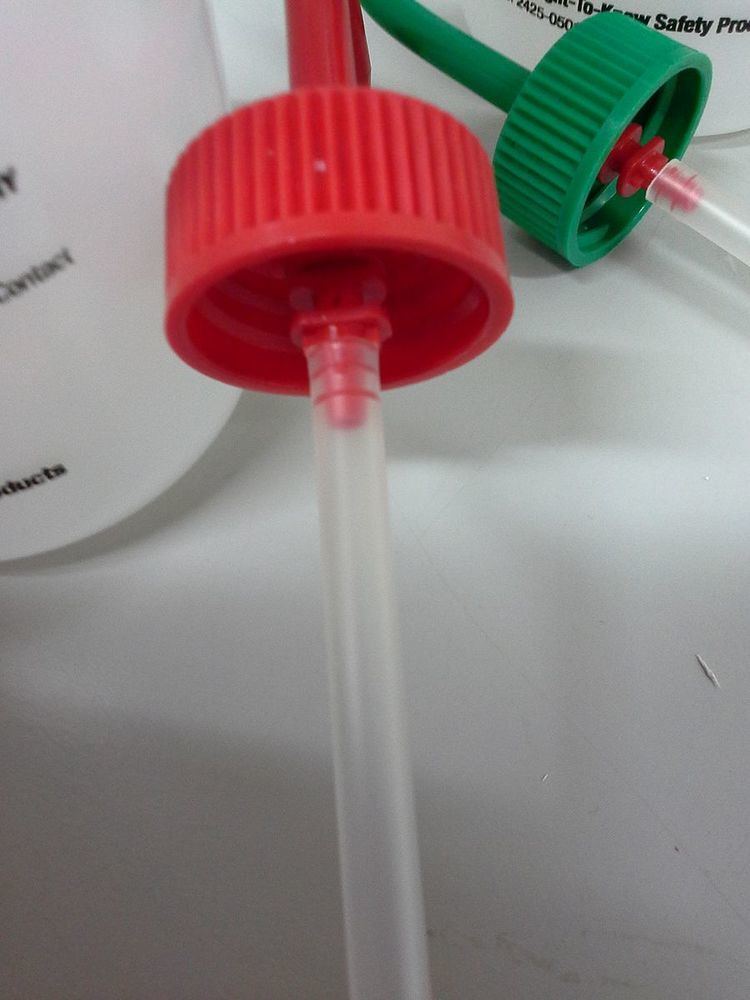Other names Squeeze Bottle | ||
 | ||
Uses To clean laboratory glassware and other equipment. They are filled with appropriate cleaning liquids, and poured over the tool that needs to be cleaned. Notable experiments The wash bottle is generally used in the clean-up phase of many experiments | ||
Definition
A wash bottle is a squeeze bottle with a nozzle, used to rinse various pieces of laboratory glassware, such as test tubes and round bottom flasks.
Contents
- Definition
- Materials of wash bottles
- Colour codes on wash bottles
- Safety
- Labels on wash bottles
- The Advantages of Wash Bottle Utilization
- Storage of Wash Bottles
- Additional information
- References
Wash bottles are sealed with a screw-top lid. When hand pressure is applied to the bottle, the liquid inside becomes pressurized and is forced out of the nozzle into a narrow stream of liquid.
Materials of wash bottles
Most wash bottles are made up of polyethylene, which is a flexible solvent-resistant petroleum-based plastic. Most bottles contain an internal dip tube allowing upright use.
Wash bottles may be filled with a range of common laboratory solvents and reagents, according to the work carried out in that lab. These include: deionized water, detergent solutions and rinse solvents such as acetone, isopropanol or ethanol. In biological labs it is common to keep sodium hypochlorite solution in a wash bottle to conveniently disinfect unneeded cultures.
Colour codes on wash bottles
To help researchers and users recognize types of substances used in laboratory especially harmful chemicals, there are a consistent set of colour codes and markings. Red color indicates that the substance in the wash bottle is acetone.White' color indicates that there is ethyl alcohol or sodium hypochlorite. Methanol is indicated by green. The yellow color indicates isopropanol and blue indicates that there is distilled water.
Safety
To be safe, put chemicals substances into wash bottles with appropriate sign of warning; therefore, the lables on wash bottles are necessary. Furthermore, do not put harmful chemicals into wash bottles for distilled water or deionized water. In addition, the holes in wash bottles lids are used for acetone and methanol.
Labels on wash bottles
Hazardous substances are classified into six principal categories including toxic, oxidizer, corrosive, flammable, explosive, and irritant . The sign for toxic substances is a skull and cross-bones. The picture of a flame with a circle in the middle of the flame indicates that the chemical substances are oxidizers. Therefore, organic materials can be burned. For the chemicals which are corrosive, the picture of an object which is corroded is the sign for this kind of substances. The picture of a flame without any circle in the middle helps recognize flammable substances. This kind of substances can result in the rapid ignity of many materials and substances.For the explosive substances, the picture of an object which is explode is used as a sign for explosive chemicals. In addition, the sign for irritant substances is the picture of the exclamation mark.
For the diamond labeling warning the danger of chemicals, red, yellow, and blue diamonds on wash bottles are scaled from 4 to 0. The number 4, 3, 2, 1, 0 on the top diamond (red diamond) representing are flammable below 21 c, below 38 c, below 93, above 93 c, and not flammable, respectively. The blue diamond on the left side is also scaled from 4 to 0 which represents deadly, extremely hazardous, hazardous, slightly hazardous, and normal material, respectively. In addition, the diamond on the right side (yellow diamond) represents the reactivity which also range from 4 to 0. The white diamond on the bottom indicate whether substances in wash bottles are air reactive, water reactive, carcinogen, and radioactive substances.
The Advantages of Wash Bottle Utilization
There are several benefits of using wash bottles. Firstly, the use of wash bottles helps researchers control and measure the amount of liquid used from wash bottles precisely. Another advantage of using wash bottles is that unwanted substances or particles cannot pass through wash bottles. Third, using wash bottles is more convenient than using beaker and graduated cylinders.
Storage of Wash Bottles
To be able to find laboratory wash bottles easily, it is necessary to keep them in the defined placed. Wash bottles can be kept by using two ring clamps which have similar size and attach to a lattice rod. This helps generate good arrangement of wash bottles in laboratories.
Additional information
Bottles of household products can be recycled as a wash bottles because there is a hold in their caps.
Different types of wash bottles are suitable with different types of substances. A spiral gas-lift wash bottle, for example, is suitable for eliminating gas with the liquid system having two phases like bromide and water. In addition, a Simple graduated wash bottle helps determine the amount of liquid used. A type of strong solvent and a type of destructive substance can be dealt with Nalgene Teflon FEP wash bottles since the special type of plastic is used to produce this type of wash bottles.
